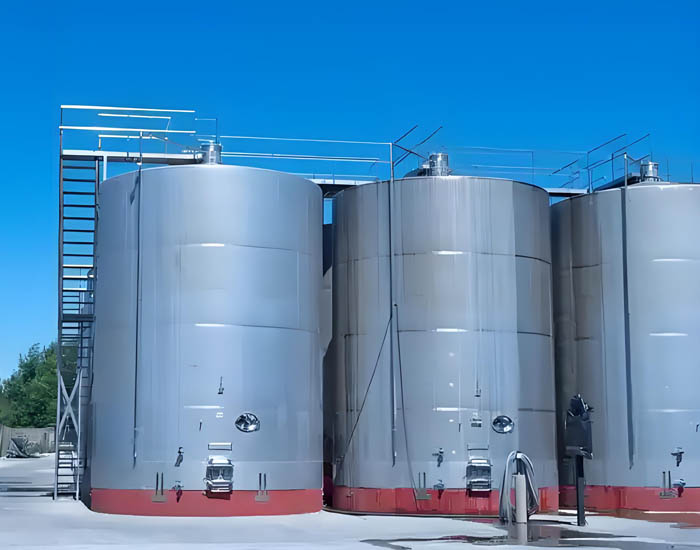The Critical Role of Chemical Storage Tanks in Industrial Applications
Chemical storage tanks are specifically designed for the safe storage of liquids and dry bulk materials, encompassing a wide range of substances from gasoline and diesel fuel to corrosive industrial chemicals. Unlike standard grain silos or cement silos, these specialized containers require chemically inert surfaces to prevent chemical reactions that could compromise structural integrity or contaminate stored products.

Chemical storage tanks can be constructed in vertical, horizontal, cylindrical, or rectangular configurations and are widely used in: petroleum refineries and fuel storage facilities, agricultural chemical processing plants, pharmaceutical production facilities, and water treatment facilities storing chlorine or acids.
Underground and Above-Ground Chemical Storage Tanks: Key Considerations
1. Underground Chemical Storage Tanks
Underground chemical storage tanks are buried beneath gas stations, industrial sites, or landscaped areas, maximizing land utilization while providing natural protection against extreme weather events (hurricanes, tornadoes), human vandalism, accidental impacts, and temperature fluctuations that could affect chemical stability.
However, their concealed installation also poses unique risks: Leak detection challenges: Even small cracks can slowly release petroleum or toxic liquids into surrounding soil, potentially contaminating groundwater aquifers. Most regions require double-walled structures for hazardous materials and interval monitoring systems.
2. Above-Ground Chemical Storage Tanks
Above-ground chemical storage tanks (commonly referred to as chemical silo) offer a cost-effective and easy-to-maintain alternative. These tanks are easy to access, allowing for routine visual inspections and simplified maintenance. They are particularly suitable for facilities requiring frequent monitoring of chemical levels and structural integrity.
Above-ground chemical storage tanks are widely used due to their lower installation costs and rapid deployment, but they are more susceptible to environmental factors, including high temperatures, extreme cold conditions, and fire risks. Appropriate protective measures, such as weather-resistant coatings and barriers, should be considered during planning and operation.
Corrosion: The Invisible Enemy of Chemical Tanks
Corrosion is the primary factor threatening the structural integrity and safety of any chemical storage tank. Different chemicals have varying reactivity, and even stainless steel or alloy surfaces can deteriorate over time without proper protection.
Advanced coating technologies are therefore critical. These coatings are specifically designed to withstand the specific chemical components inside the tank and external environmental factors.
Coating Technologies for Chemical Storage Tanks and Storage Containers
The use of coatings on Chemical Silos and Chemical Storage Tanks helps prevent corrosion, reduces maintenance frequency, and extends the tank’s operational lifespan. Commonly used coating systems include:
- Epoxy coatings: Highly resistant to chemical corrosion, suitable for dry bulk materials and liquid chemicals. Epoxy coatings are renowned for their durability and non-reactivity.
- Glass-fused steel: Provides high-level protection in corrosive chemical environments; suitable for long-term storage applications.
- High-temperature coatings: Suitable for tanks exposed to high temperatures or thermal process chemicals.
- Low-temperature coatings: Specifically designed for tanks installed in harsh cold climates to prevent cracking and peeling.
- Galvanized coatings: Most suitable for dry bulk chemicals such as powders and granules, providing protection against rust and atmospheric corrosion.
Selecting the appropriate coating requires a thorough analysis of the stored material, temperature, and environmental exposure. Incorrect coating selection may lead to unintended chemical reactions, equipment failure, and environmental damage.
Coating technology is not merely a surface treatment—it is a core strategy for sustainable chemical storage management. With ongoing advancements in materials science and corrosion engineering, today’s coatings offer more durable and environmentally friendly solutions than ever before.
Why choose AGC chemical tanks?
With over 1,000 successful installations across 32 countries, AGC offers:
✔ Corrosion-resistant design—featuring a proprietary GFS coating with a 20-year warranty
✔ Hazardous materials expertise—ATEX-compliant tanks suitable for flammable chemicals
✔ One-stop solutions—from seismic calculations to automated filling systems
Request a customized quote today—our chemical storage engineers will design a tank solution tailored to your specific capacity requirements and material safety standards.
Leave a Reply